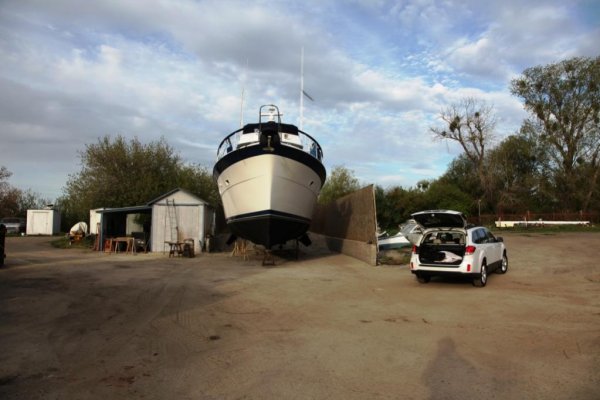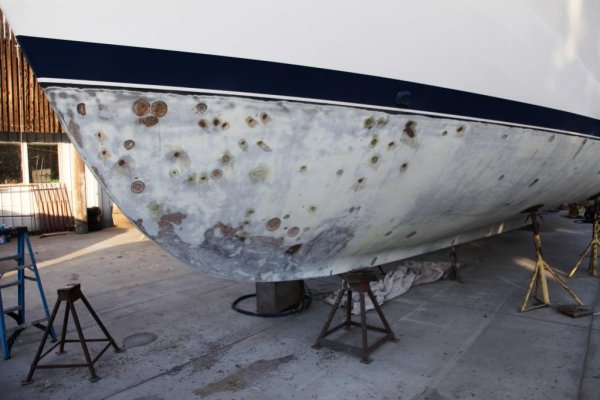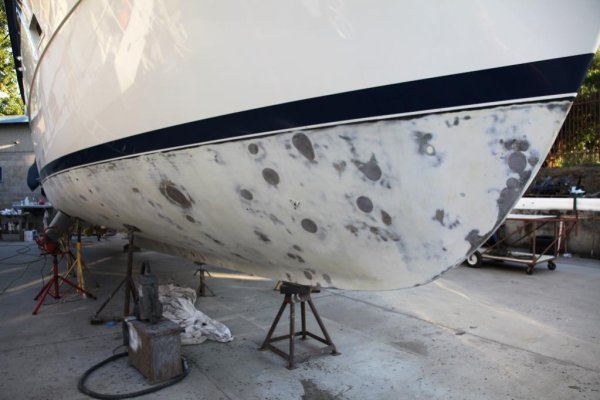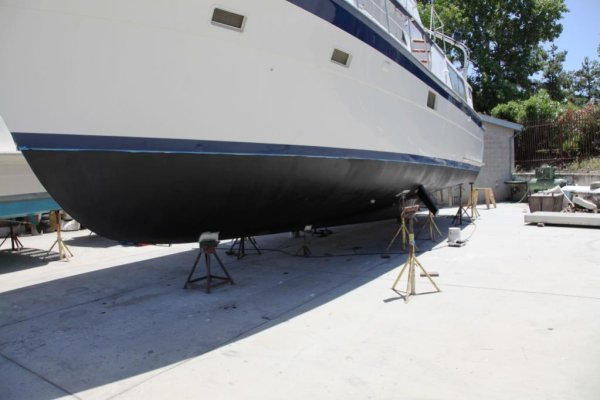Scary
Guru
I thought I would share some experience learned while repairing the blisters on my 48 LRC.
At haul out four years ago for a survey, about 90 blisters were noted.
Being a believer that blisters are cosmetic, at least on a Hatteras, we put the boat back in the water.
Because of the number of blisters and the amount of bottom paint on my boat I felt it would be cost effective to sandblast the bottom to get rid of the old barrier coat and expose as many blisters as possible.
Six hours of sandblasting got us down the the first original barrier coat and bare glass.
My boat had been barrier coated about 15 years ago.
In the afternoon light the bottom looked like a feral cement hull, pretty rough.
The original barrier coat had sagged and had been unevenly applied.
There is a lot of bottom surface area on the 48LRC to flatten. There was also at least 200 blisters ranging in size from 8" to the size if a dime. Some of the blisters were shallow gel coat blisters and the rest were down to the first layer of roving. About a half to five eights of an inch deep.
Blisters tend to form at the transition of mat or chopper to the roving as the those loose fibers act as wicks for moisture.
My coarse of action was to repair the blisters with mat and polyester resin, two epoxy barrier coats and two coats of epoxy bottom paint.
Procoat was chosen as it is midpriced and the yard has had good results with their products. This should give me another 10 years or so of a blister free bottom( maybe).
I would like to offer my opinion on repairing fiberglass boats with epoxy fillers.
Epoxy will stick better to wood but it has downsides when it comes to working on a boat made with polyester or vinylester resin.
It is very hard to wet out mat with epoxy and epoxy shrinks and sags out of vertical repairs.
Epoxy mixed with glass fiber or cabosil is a tough filler but much harder to fair than polyester or vinylester mixes.
Polyester resin is much more flexible to work with as you can very cure time easily. Polyester sands at the same hardness as your boat so fairing is much easier.
The other problem with epoxy is polyester doesn't stick well to epoxy so once you use it you have to continue using it or grind it completely out of the blister or repair.
Polyester is a lot easier to work with and half the cost of epoxy.
Larger blisters are repaired a couple of ways, filling the craters with layers of mat disks wetted out with resin and rolled out or filled with filler made up of chopper glass and resin thickened to the consistency of peanut butter.
Both methods work, the chopper glass mixture faster and the mat disks thought to be stronger. The smaller blisters can be filled with resin and cabosil.
I've included some pictures of the process. The second image shows failed epoxy repairs that had to be redone with polyester after three days of grinding out the failed repairs.
At haul out four years ago for a survey, about 90 blisters were noted.
Being a believer that blisters are cosmetic, at least on a Hatteras, we put the boat back in the water.
Because of the number of blisters and the amount of bottom paint on my boat I felt it would be cost effective to sandblast the bottom to get rid of the old barrier coat and expose as many blisters as possible.
Six hours of sandblasting got us down the the first original barrier coat and bare glass.
My boat had been barrier coated about 15 years ago.
In the afternoon light the bottom looked like a feral cement hull, pretty rough.
The original barrier coat had sagged and had been unevenly applied.
There is a lot of bottom surface area on the 48LRC to flatten. There was also at least 200 blisters ranging in size from 8" to the size if a dime. Some of the blisters were shallow gel coat blisters and the rest were down to the first layer of roving. About a half to five eights of an inch deep.
Blisters tend to form at the transition of mat or chopper to the roving as the those loose fibers act as wicks for moisture.
My coarse of action was to repair the blisters with mat and polyester resin, two epoxy barrier coats and two coats of epoxy bottom paint.
Procoat was chosen as it is midpriced and the yard has had good results with their products. This should give me another 10 years or so of a blister free bottom( maybe).
I would like to offer my opinion on repairing fiberglass boats with epoxy fillers.
Epoxy will stick better to wood but it has downsides when it comes to working on a boat made with polyester or vinylester resin.
It is very hard to wet out mat with epoxy and epoxy shrinks and sags out of vertical repairs.
Epoxy mixed with glass fiber or cabosil is a tough filler but much harder to fair than polyester or vinylester mixes.
Polyester resin is much more flexible to work with as you can very cure time easily. Polyester sands at the same hardness as your boat so fairing is much easier.
The other problem with epoxy is polyester doesn't stick well to epoxy so once you use it you have to continue using it or grind it completely out of the blister or repair.
Polyester is a lot easier to work with and half the cost of epoxy.
Larger blisters are repaired a couple of ways, filling the craters with layers of mat disks wetted out with resin and rolled out or filled with filler made up of chopper glass and resin thickened to the consistency of peanut butter.
Both methods work, the chopper glass mixture faster and the mat disks thought to be stronger. The smaller blisters can be filled with resin and cabosil.
I've included some pictures of the process. The second image shows failed epoxy repairs that had to be redone with polyester after three days of grinding out the failed repairs.
Attachments
Last edited:







